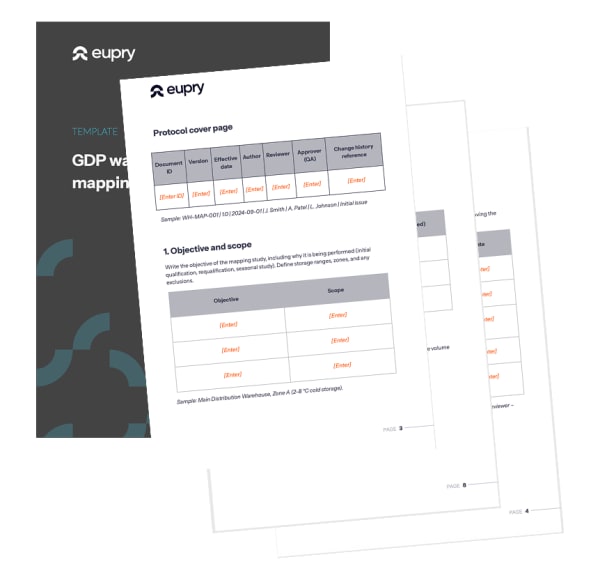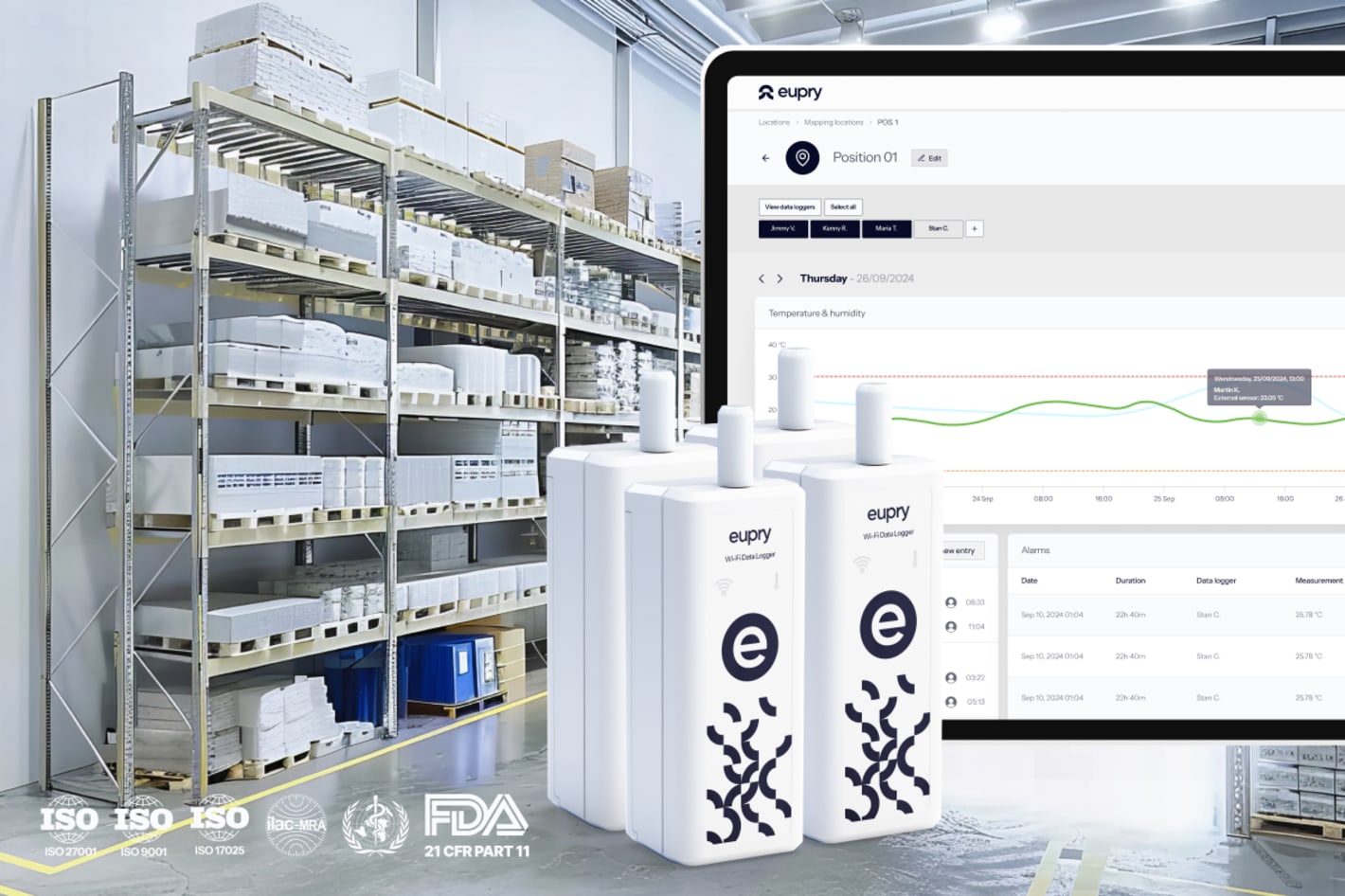Temperature mapping for GDP pharmaceutical warehouses
Pharmaceutical warehouses must be qualified to show they can consistently maintain relevant conditions for storing medicine, and temperature mapping is a critical step required before a warehouses can be taken into use. This guide explains how to plan, execute, and document mapping in line with GDP and USP <1079.4>.
Get a ready-to-use template aligned with GDP, WHO, and USP <1079.4>.

What are the GDP requirements for temperature mapping of pharmaceutical warehouses?
GDP and USP <1079.4> require warehouses to be mapped before use and re-mapped when risk factors justify it. The temperature mapping study must use calibrated sensors and a documented protocol with predefined acceptance criteria and rationale. Results are used to show the warehouse maintains labelled conditions and to identify where permanent monitoring sensors should be placed.
- Initial mapping: Perform before first use under representative conditions. WHO guidance indicates 7–14 days is typical, but the duration must be justified by risk.
- Calibrated equipment: Use sensors calibrated at relevant points, traceable to national standards.
- Protocol approval: Define objectives, acceptance criteria, sensor plan, duration, and reporting.
- Risk-based requalification: Repeat after changes in layout, HVAC, storage capacity, or if trend data indicates instability. Also see: Eliminate re-mapping with the continuous mapping framework.
How to design a GDP warehouse mapping protocol
A protocol sets the foundation for a compliant study. It should be approved before execution, and the scope, acceptance criteria, responsibilities, equipment, and tests should be defined. Including a rationale for sensor count and placement is expected by regulators.
Also see: GxP-compliant temperature mapping equipment
- Objectives: Show that the warehouse maintains labelled ranges and identify hot and cold spots.
- Scope: Define areas, temperature ranges, and exclusions.
- Acceptance criteria: Predefine allowable variability, maximum excursions, and duration with documented rationale.
- Sensor plan: Justify the number and placement based on risk, volume, and layout. Learn more: "Data logger calculator for mapping: How many do you need for your warehouse?"
- Test conditions: Define representative operating conditions; include door openings and power interruptions if risk warrants.
- Duration: Explain and justify study length, typically 7–14 days or as risk dictates. Regulators expect justification if seasonal studies are not performed.
Download a free GDP warehouse mapping protocol template here ✅
How to execute a GDP warehouse temperature mapping
Execution must follow the approved protocol, and careful planning at this stage prevents audit findings. Teams should coordinate installation, verification, and documentation in a structured manner. Many regulators expect that every action is recorded, deviations are addressed, and that the analysis provides clear evidence that the warehouse is fit for purpose.
-
Installation: Mount sensors securely, label them, and record their positions in a location plan that is archived with the study.
-
Data integrity: Synchronize clocks, protect data, and ensure audit trail following ALCOA+ principles (Attributable, Legible, Contemporaneous, Original, Accurate, plus Complete, Consistent, Enduring, Available).
-
Verification: Check sensor functionality and calibration certificates before starting, and document the checks.
-
Deviations: Document any departures from protocol, explain root cause, and assess potential impact on study validity.
-
Analysis: Evaluate variability, excursions, and whether acceptance criteria were met; document statistical methods if applied.
-
Hot/cold spots: Identify and document locations for permanent monitoring and provide rationale for final recommendations.
Also read: Temperature mapping: tips, frameworks, and pitfalls

Download a free warehouse mapping protocol
Get a step-by-step mapping protocol template to help you plan, execute, and document mapping of pharmaceutical warehouses aligned with GDP and USP <1079.4>.
How to report GDP warehouse temperature mapping results
Reporting should demonstrate that the study followed the protocol, show results against acceptance criteria, and include recommendations for [monitoring](/temperature-monitoring). Reports should be signed and approved by Quality (QA), archived in the quality system, and available for audits.
- Protocol adherence: Confirm that execution followed the approved plan.
- Results: Present temperature profiles, excursions, and variability.
- Acceptance decision: State whether the warehouse met the criteria, with a rationale.
- Recommendations: Translate findings into monitoring placement and alarm limits.
Also read: Continuous temperature mapping – eliminate re-mappings with Eupry
Temperature mapping protocol for pharma warehouses
Plan and document your mapping studies according to WHO, ISPE, and GDP guidelines and requirements using this plug and play mapping protocol template.

FAQ: Temperature mapping of pharmaceutical warehouses
Learn more
- Temperature compliance for pharmaceutical warehouses: GDP requirements and best practices
- Temperature mapping: Tips, frameworks, and pitfalls
- Pharmaceutical warehouse monitoring: How to stay GDP ready
- Digital GDP-compliant temperature mapping solutions - how do they work?
- Continuous temperature mapping – eliminate re‑mappings

Digital temperature mapping solutions for pharma warehouses
Perform GxP-compliant temperature mappings tailored to your operation in less time, at a lower cost, and with full compliance confidence with specialized, flexible, and engineer-led temperature mapping solutions built for GxP.
- On-site and remote options
- Digital reporting in specialized mapping software
- The fastest calibration on the market included
